Dr. Todd Restores A Reel … Or How To Clean Fishing Reels for Dummies
Cleaning reels is easy. Like REALLY easy. So easy, in fact, it is rather astounding that more collectors (and dealers) don't do it. It really does not not take a lot of time or money to turn what is in many cases a worthless $5 junk reel into something of real value -- and the best part is that we now have a bible for reel cleaners and restorers. Whether you're cleaning your first reel, or you are restoring the hard rubber plate on a $3000 vom Hofe, the new book Cleaning, Restoring and Repairing Antique Fishing Reels, published by the fine folks at ORCA, is an absolute MUST HAVE, even if you only buy reels to resell them.
To show you how easy it is to turn a junker into a beauty that any collector would be proud to display, I am going to walk you through the process from start to finish -- as it is outlined in a chapter by Dr. John Elder in the aforementioned book. I am going to add a twist of my own, simply because I am an absent-minded professor about 98% of the time and often forget how to put reels back together. I developed an easy-to-use trick if, like me, you sometimes forget how reels go back together.
So let's start with the candidate reel. I am working on a documentary film about the Pflueger Supreme reel, and as ancillary part of the research, I needed to find a couple of Pflueger Oceanic Free Spool reels in order to photograph their Case-patent free spool mechanism. I was not looking forward to spending the $150 or so necessary to acquire the two early models I needed, but as luck would have it, I found a lot of 7 "beater" reels on eBay that had not one but both of the Oceanics I needed (the first generation "Patent Pending" 300-yard and the 250-yard second model). Trouble was, they were in absolutely awful condition, which explains how I was able to purchase the entire lot for $25.45 including shipping.
The 250-yard Oceanic is on the left in this auction photo, with the free spool lever put on backwards. As you can see, it looked terrible.
How awful? When it arrived I snapped some photos of it to show just how much corrosion and gunk had accumulated on this reel.
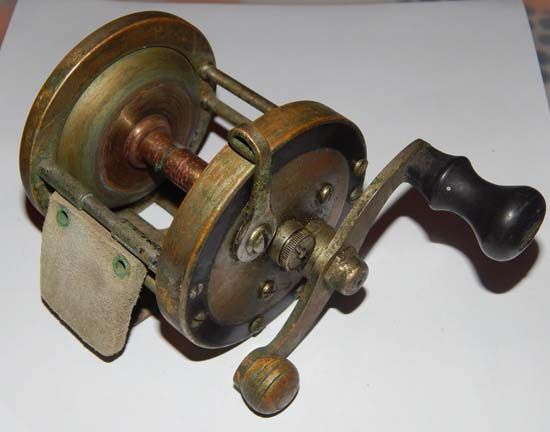
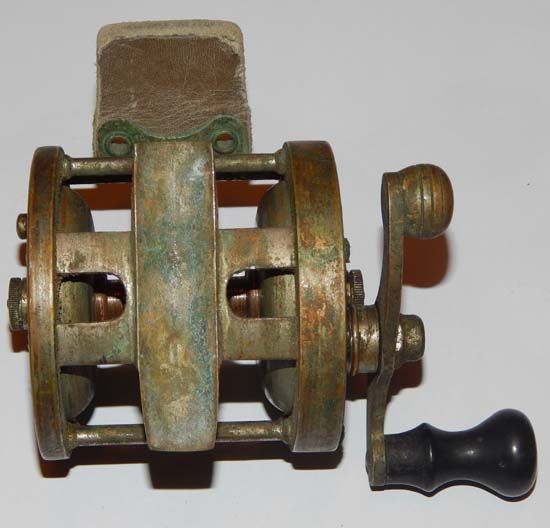

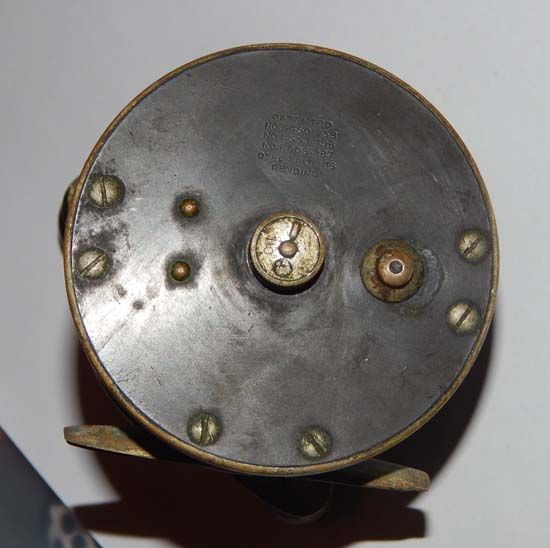
First thing I did was put the free spool lever back on the right way. An honest question -- looking at this reel, do you think you could get $10 at a flea market for it? If you could, you are a better salesman than anyone I know.
But knowledge is a good thing. Many of these early saltwater surf reels were built much better than we give them credit for, and could survive some significant abuse. I knew that Oceanics in their early permutation were German Silver, meaning that they avoided the pitting from corrosion better than nickel plated reels. The reel worked poorly, with a weak click. I knew that the fact it did not run well was likely due to an internal build up of gunk. It would have to be cleaned inside and out.
Since I needed this reel for the film, it had to be cleaned, because if there is one thing my ORCA friends HATE more than anything is dirty reels being used to illustrate points on reel history, I knew I had to clean this baby up the best I could. So I consulted the Cleaning, Restoring and Repairing Antique Fishing Reels book chapter by Dr. Elder and procured the necessary items for a thorough reel cleaning:
1) Vinegar
2) 0000 Steel Wool
3) Mineral Spirts
4) Metal polish (I am partial to Maas)
5) Gunsmithing screwdrivers
A tupperwear container, some old toothbrushes, and an old t-shirt rounded out the list of necessary items.
THAT'S IT. Literally, these were the tools I used to clean the Pflueger Oceanic pictured in this article.
STAGE ONE: Disassembly
A word on screwdrivers -- I strongly suggest anyone who collects vintage tackle buy a set of gunsmithing screwdrivers. I can't overestimate the importance. I am partial to Chapman screwdrivers, with interchangeable heads. A simple set costs $30 and has 20 heads that will fit almost anything you come across. The worst possible thing you can do is bugger a screw; there is lots of good information on how to avoid this in the aforementioned book.
Luckily, I had the correct size head for the screws on this reel. But as I mentioned I often forget where parts go in a reel, so I've developed to the following fool-proof method of disassembling a fishing reel.
First, take a good digital photo of the reel, front and back. Then print out as large a photo as your printer will allow, like so:
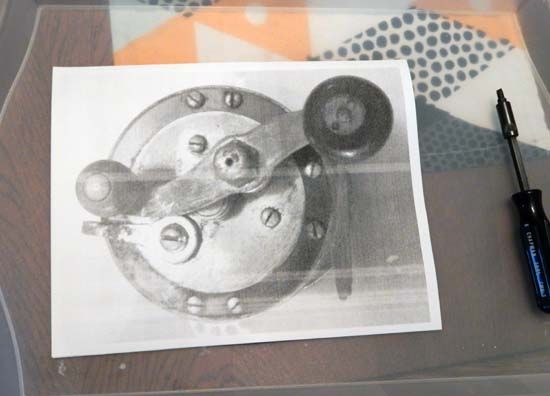
Then, take a pen and mark all the pieces you will be taking off the front plate of the reel with a number. Then simply take off each piece one by one, and tape it to the corresponding place on the photo like so:
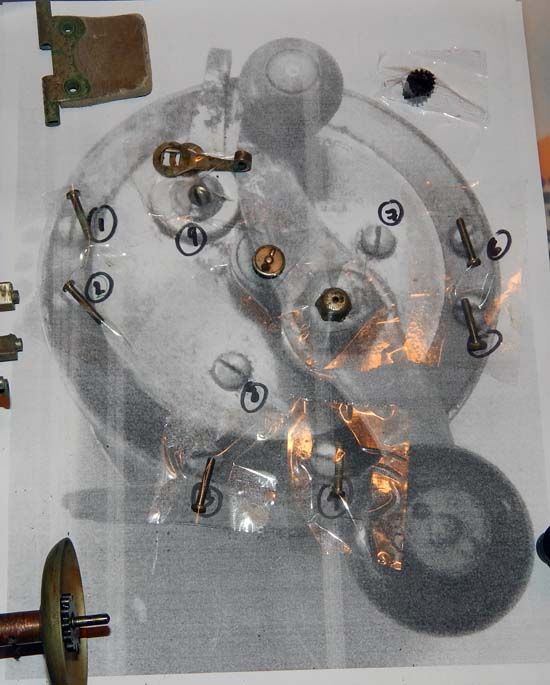
Yep. Simple as that. You'll never forget what screw goes where. I know what you're thinking: why didn't' I think of that? Simple answer: you need to dunce up a lot of reels to come up with something this ingenious.
Anyway, since one of the screws holding the end plate to the foot was "frozen" I left that piece on, knowing that the "soak" would help me to remove the screw later.
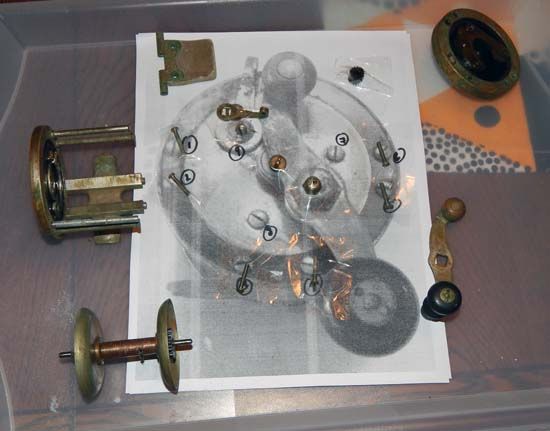
The soak is simple: 50% vinegar and 50% water. That's it. Put your 50-50 mixture in a tupperware container and then place the reel parts in it, put the top on it, and wait overnight.
Total elapsed time spent on cleaning this reel so far: 20 minutes.
STAGE TWO: Cleaning
You can soak your reel for as little as four hours and for as long as 24; the book gives a variety of opinions on the subject. I soaked for 12 hours and then in a sink full of hot water (and TWO drain catches in case something valuable fell out) I put the reel parts, and carefully using 0000 steel wool, began to scrub the Oceanic. The vinegar did its job beautifully, lifting dirt and gunk from the tiniest of cracks and preparing the corrosion on the spool and face and end plates for cleaning.
By the way, it is the experience of the authors of the ORCA book that vinegar will not harm hard rubber.
0000 steel wool is perhaps the greatest cleaning tool you can have. It's so fine it won't leave scratch marks, but rough enough to take off the corrosion and layers of oxidation built up over years of use in saltwater.
For internal cleaning, Dr. Elder recommends a fine wire brush, but I find a toothbrush is a great tool. I use Dawn dishwashing soap and an old toothbrush to scrub the gearing and the internal of the reel. I find this is usually sufficient to clean the reel, but if there is stubborn gunk, Dr. Elder recommends a bath in mineral spirits, which would be the same process as the vinegar-water soak (and like your 50-50 solution, is completely reusable).
After an initial scrubbing with the steel wool, this is what the parts looked like:
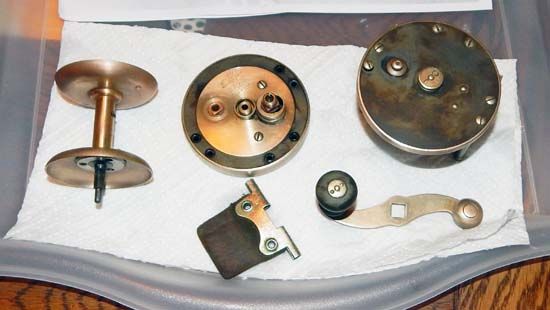
Time spent on this stage: 15 minutes. Total elapsed time spent on cleaning this reel so far: 35 minutes.
STAGE THREE: Polishing and Reassembly
Now comes the polishing. Taking each of the parts from the soak, thoroughly dry them with some paper towels, and let them sit for a few hours (if you are impatient you can put them on a tray on a food dehydrator which will use gentle air and warmth to dry them in about 15 minutes).
Once dry, begin to polish the individual parts with Maas (or whatever metal polish you prefer). DON'T OVERPOLISH. In my opinion your goal is NOT to make it look brand new, but to make it look like a clean fishing reel that can be taken out and fished. So I don't try to polish until it has a mirror finish although you are welcome to do so if you desire.
Since the soak had loosened the stubborn screw on the back plate, I used the photo of the back plate and taped all the screws to the photo so I knew where they came from, and completely disassembled the reel. This allowed me, for example, to more thoroughly polish the pillars and the foot, which were far easier to do loose than when attached to the end plate. Then taking each screw I cleaned them individually (the easiest way is to take a piece of cloth and a tiny bit of polish and "screw" it into the cloth using the screwdriver -- this cleans the entire screw very effectively).
Here is where your "road map" photo will come in handy. Using the photos with the parts taped to them, after cleaning each screw, replace it back to the exact place where it came from on the reel. It's remarkably easy and you'll never have the problem of the wrong screws (that look alike) going in to the wrong part of the reel ever again.
Reassembly is a snap. It is rather shocking how different the reel appears even at this stage.


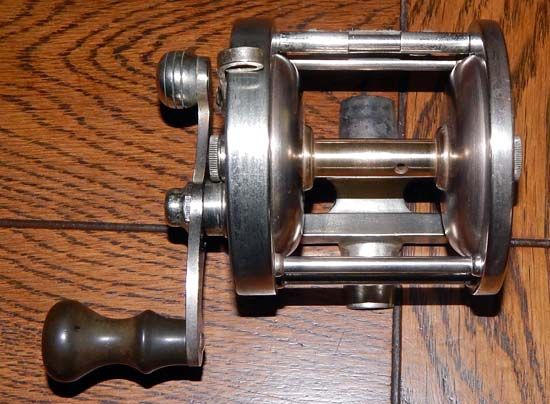
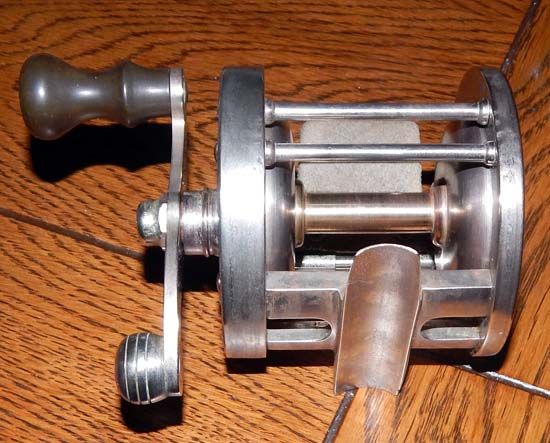
Time spent on this stage: 15 minutes. Total elapsed time spent on cleaning this reel so far: 50 minutes.
STAGE FOUR: Final polishing
The last stage is the final polishing one, which is to take the assembled reel, and using a cloth and tiny amount of polish, to do a thorough and final job of going over the reel one last time.
Once this is done, take a clean cloth and go back over the reel about three or four times. Make sure to clean the spool by putting a cloth on it and reeling it for a minute or so. The polish should all be gone now, and you'll have a reel that looks like this:
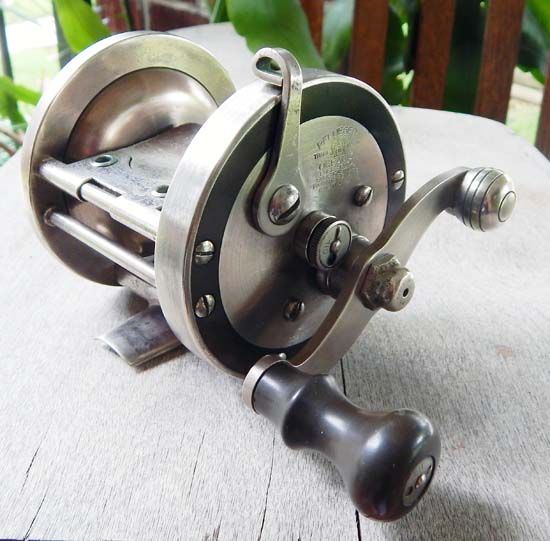
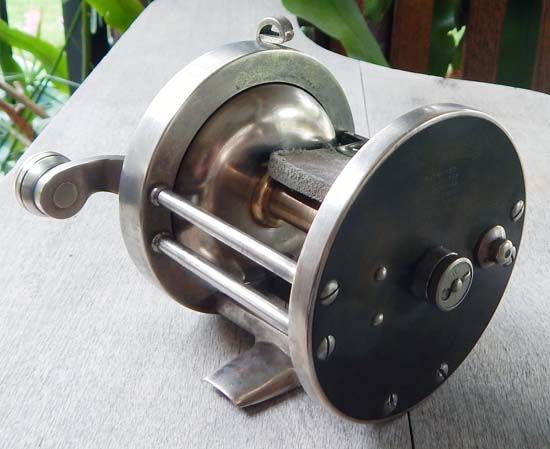
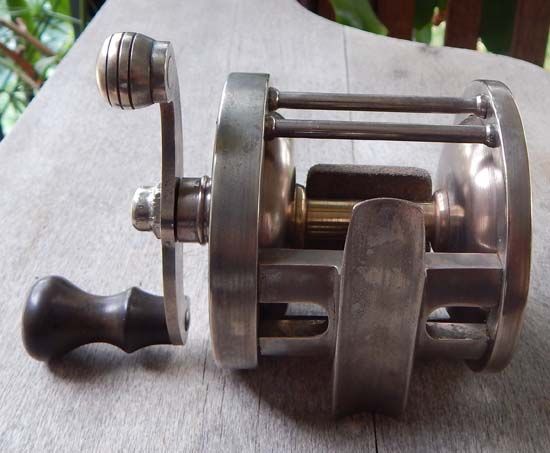
Time spent on this stage: 10 minutes. Total elapsed time spent on cleaning this reel so far: 60 minutes.
So that's it. A reel you wouldn't spend $5 on now would not look out of place on any collector's shelf. The transformation is rather remarkable, and is just so incredibly easy I can't believe every collector or dealer doesn't do it.
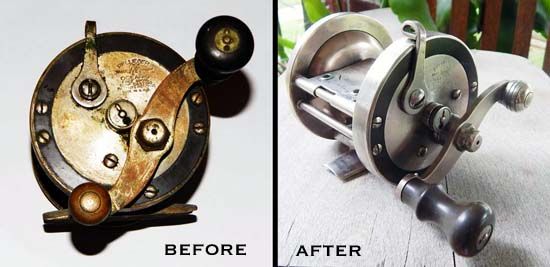
There's still a little work left to do; I always wait a week before disassembling the reel again and greasing and oiling it, just to make sure that it is completely dry. Then I take a clean cloth and give it one more polish. In this case, since it had an aftermarket leather thumb drag, I will also restore the leather as well as it can be, but that is it.
I hope you'll see how easy this was. The Cleaning, Restoring and Repairing Antique Fishing Reels book is about the only manual you'll ever need on the subject, and I hope everyone interested gets a copy. An hour of your time will do wonders to just about any reel.
Additionally, check in tomorrow -- we'll have a special announcement about reel cleaning.
-- Dr. Todd
PROVISO: The rarer and more valuable a reel, the more care that is necessary to clean it. Don't use steel wool on a fine Kentucky reel, for example. If you have a rare reel, or have any difficulties cleaning your reel, please post to the ORCA Reel Talk "Cleaning" forum. To visit the forum and ask a question, Click Here.
6 comments:
Excellent job, Dr. Todd. Good form, my man!!! There are so many good & usable pieces of tackle out in the world that sadly get passed over or neglected because of their appearance - i.e. corrosion & grime build-up. That's unfortunate because if you're willing to give it a few minutes of your time, as you have shown here, you could have a nice looking, & very usable, piece of tackle to take fishing.
I agree, 0000 steel wool is extremely useful. I use it for so many things not only in the rod shop, but also around the house. I'd be at a loss without it.
One tip for 0000 steel wool: if you have a piece of chromed metal that needs a quick cleaning, saturate a piece of 0000 steel wool with a good glass cleaner & gently polish the chrome with it. Wipe it dry with a clean cloth & it's back to being clean & shiny again.
Great job describing this process. You've helped a lot of folks here & this was a fantastic post. Thanks Dr. Todd.
-Chris Lantzy
i really liked your article and pics on reel cleaning. i look forward to seeing your documentary on the Pflueger Supreme reel.
Bill Zumbro
@Chris -- thanks a ton! That is an awesome tip about glass cleaner! I'll definitely be adding that to the arsenal.
@Bill Z -- the supreme video started out 12 minutes and is working its way up to 40 ... don't know how it is doing that!
My Pflueger Oceanic Free Spool 250 has a cork spool. It does not have the metal as shown. Question when soaking in the vingine and water mix with it damage the cork??
I have some vintagr reels I was told are common mass produced reels worth about 20 bucks each. They still actually work. Just wondering if they'd be worth a restore to anyone. Would their value increase any. Would it be worth it to spend the time or should I just chuck them? I signed up for the Web site listed at the end of this post but if anyone is interested let me know.
Post a Comment